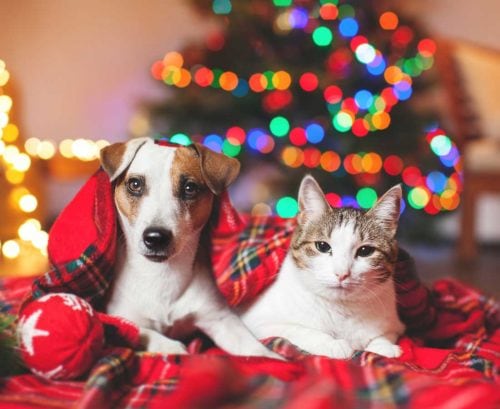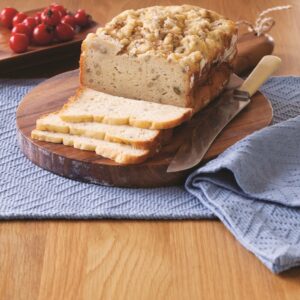
Christmas is a wonderful time to relax with family and friends, both two and four legged. But it can be a scary and dangerous time for pets. Food, presents, decorations and even visitors to our homes can all become hazards. Vets typically report the festive season as being one of their busiest times of year.
Knowing the dangers is key. It is also important to let everyone in the house know what is safe and what is not for family pets. Prevention is always better than cure.
Visitors can be advised on pet etiquette, too. Some pets can get distressed by changes to their routine and anxious in the presence of unfamiliar people. Unfortunately, this has been exacerbated by the pandemic. Be especially aware of leaving dogs unsupervised around excited or unknown children as bites are a real risk. Providing your pet with a safe, quiet space might be important to protect both your visitors and your pet.
Festive foods are a particular problem. A tasty treat for us can be fatal for some pets, so beware of sharing your festive meals with your pets. Some animals will be sensitive even to slight dietary changes, perhaps showing signs of digestive upset and discomfort.
Dogs tend to be less discriminating in their food choices than cats. This means that our dogs might be more likely to eat things they shouldn’t, but care should be taken with cats, too.
Pancreatitis is a painful and distressing condition often seen in dogs who have consumed fatty foods. Avoid giving leftovers to your pets to reduce this risk. Cooked bones can also cause significant injury, so make sure they can’t get into the bins to steal scraps.
Mince pies, Christmas cake and puddings are full of raisins – which are toxic to dogs. Grapes, currants and sultanas are also dangerous for dogs and are hidden in many festive recipes. And macadamia nuts are a health hazard, causing a range of symptoms including weakness, vomiting, stiffness and depression. Other nuts and seeds can pose a choking risk.
Alcohol needs to be strictly limited to human-only consumption. Rotting apples have even caused alcohol poisoning in dogs, so keep food waste and leftovers out of harm’s way, too. Access to raw bread dough, blue cheese and salt-dough ornaments should also be avoided as they contain compounds that can cause significant illness.
Similarly, onions, garlic and chives contain chemicals that are toxic to cats and dogs – and cooking doesn’t make them safer. As little as a single spoonful of sage and onion stuffing can cause harm.
Sweet treats are no safer. Chocolate is a significant concern, and holidays are associated with an increased risk of chocolate toxicity. Even artificial sweeteners, such as xylitol – which is commonly used in chewing gum – should be avoided.
Not just food
Wrappers from sweets and chocolates can pose a risk if consumed. Indeed, digestive foreign bodies are a common problem for dogs and cats, often requiring emergency surgery. If consumed, toys, gifts and decorations can cause intestinal blockage and damage.
Be aware of plant hazards, too. Needles from Christmas trees can penetrate paws, causing pain and infection. Other festive plants such as poinsettia, mistletoe and holly berries are toxic if consumed. The leaves, petals and pollen of lilies are especially dangerous for cats.
Antifreeze is another hazard for cats with the ingestion of small amounts potentially fatal. Colder temperatures mean antifreeze is commonly used on our vehicles and spillages can occur. Occasionally it is also found in some decorations, such as snow globes, so care should be taken to prevent inadvertent access by our pets.
In any case, where you think your pet has eaten or otherwise been exposed to something potentially nasty, it is best to seek veterinary advice as soon as possible. By taking a bit of care over the festive season, we can all make sure it is a safe and restful time for us, our pets and our pets’ vets.![]()
This article is republished from The Conversation under a Creative Commons license. Read the original article.
You might also be interested in:
Article sources and references
- Jarvis, S. (2017), No chocolate for Fido. Veterinary Record, 181: 665-665. https://doi.org/10.1136/vr.j5890https://doi.org/10.1136/vr.j5890
- Fein J, Bogumil D, Upperman JS, et alPediatric dog bites: a population-based profileInjury Prevention 2019;25:290-294.https://injuryprevention.bmj.com/content/25/4/290
- Shukla A. Acute pancreatitis attributed to dietary indiscretion in a female mixed breed canine. Can Vet J. 2010;51(2):201-203.https://www.ncbi.nlm.nih.gov/pmc/articles/PMC2808289/
- Schweighauser, A, Henke, D, Oevermann, A, Gurtner, C, Francey, T. Toxicosis with grapes or raisins causing acute kidney injury and neurological signs in dogs. J Vet Intern Med. 2020; 34: 1957– 1966. https://doi.org/10.1111/jvim.15884https://onlinelibrary.wiley.com/doi/10.1111/jvim.15884
- Hansen SR, Buck WB, Meerdink G, Khan SA. Weakness, tremors, and depression associated with macadamia nuts in dogs. Vet Hum Toxicol. 2000 Feb;42(1):18-21. PMID: 10670081.https://pubmed.ncbi.nlm.nih.gov/10670081/
- Kammerer M, Sachot E, Blanchot D. Ethanol toxicosis from the ingestion of rotten apples by a dog. Veterinary and Human Toxicology. 2001 Dec;43(6):349-350. PMID: 11757994.https://europepmc.org/article/med/11757994
- Means, C. (2003), Bread dough toxicosis in dogs. Journal of Veterinary Emergency and Critical Care, 13: 39-41. https://doi.org/10.1046/j.1435-6935.2003.00068.xhttps://onlinelibrary.wiley.com/doi/abs/10.1046/j.1435-6935.2003.00068.x
- Noble, P.-J.M., Newman, J., Wyatt, A.M., Radford, A.D. and Jones, P.H. (2017), Heightened risk of canine chocolate exposure at Christmas and Easter. Veterinary Record, 181: 684-684. https://doi.org/10.1136/vr.104762https://bvajournals.onlinelibrary.wiley.com/doi/full/10.1136/vr.104762
- Hayes, G. (2009), Gastrointestinal foreign bodies in dogs and cats: a retrospective study of 208 cases. Journal of Small Animal Practice, 50: 576-583. https://doi.org/10.1111/j.1748-5827.2009.00783.xhttps://doi.org/10.1111/j.1748-5827.2009.00783.x
- Potter, A., Yeates, J. and Gaines, S. (2015), Diagnosis and reporting of antifreeze poisoning. Veterinary Record, 177: 630-630. https://doi.org/10.1136/vr.h6831https://bvajournals.onlinelibrary.wiley.com/doi/full/10.1136/vr.h6831
www.healthyfood.com










